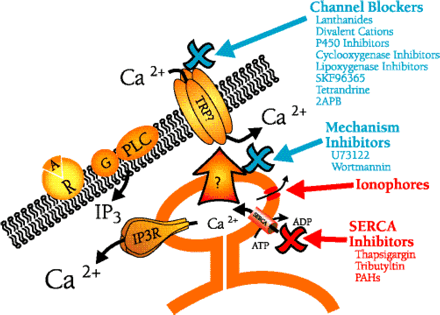
- Institution: Stanford Univ Med Ctr Lane Med Lib/Periodical Dept/Rm L109
- Sign In as Member / Individual
Pharmacology of Capacitative Calcium Entry

Pharmacology of capacitative calcium entry. Capacitative calcium entry is initiated physiologically by agonists ( ) activating surface membrane receptors (
) activating surface membrane receptors ( ) that are coupled to phospholipase C (PLC), in many instances through a heterotrimeric G-protein (G).Phospholipase C liberates
IP3 from membrane polyphosphoinositides; IP3 in turn binds to its receptor (IP3R) on the endoplasmic reticulum, thereby causing release of stored Ca2+. The fall in stored Ca2+ then, by a mechanism the nature of which is controversial, activates plasma membrane calcium channels. These channels (TRP?)
may be members of the TRP family.
) that are coupled to phospholipase C (PLC), in many instances through a heterotrimeric G-protein (G).Phospholipase C liberates
IP3 from membrane polyphosphoinositides; IP3 in turn binds to its receptor (IP3R) on the endoplasmic reticulum, thereby causing release of stored Ca2+. The fall in stored Ca2+ then, by a mechanism the nature of which is controversial, activates plasma membrane calcium channels. These channels (TRP?)
may be members of the TRP family.
The sites of action (in some instances proposed) for a number of reagents discussed in this review are shown. Those in blue inhibit capacitative calcium entry, whereas those in red activate capacitative calcium entry. The largest group consists of compounds that act, or are presumed to act, as blockers of capacitative calcium entry channels (Channel Blockers). These agents for the most part have limited specificity, with the exception of 2APB, which appears to be specific for capacitative calcium entry channels relative to other known surface membrane calcium channels. U73122 (a phospholipase C inhibitor) and wortmannin (a phosphatidylinositol kinase inhibitor) do not appear to block channels directly, but rather appear to inhibit the mechanism underlying channel activation (Mechanism Inhibitors). Ionophores cause release of stored Ca2+ from the endoplasmic reticulum, and thus bring about activation of capacitative calcium entry. Inhibitors of SERCA pumps, such as thapsigargin or certain toxins, also cause depletion of Ca2+ stores leading to activation of capacitative calcium entry.


